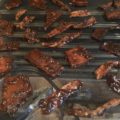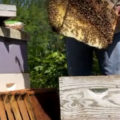All you need to pasteurize milk at home is a stove, stainless steel pot, and a thermometer. You slowly warm the milk to 145F and hold the temperature there for 30 minutes. Once done, you’ll quickly cool the milk down to 40F (by putting the pot in a sink with ice water) and then store in the refrigerator.
Using a stovetop however, comes with a few things you’ll need to watch.
First, when warming your milk, you’ll want to stir it often to keep the heat dispersed throughout. If you let it sit too long without stirring, it can scorch (or scald). It can also scorch if you heat it too quickly. If you have a double-boiler, this is even better then a single pot and decreases the likelihood of scorching.
I put a dedicated thermo probe in the milk so that I know its temperature at all times. Once you’ve reached your target temp of 145F, you’ll need to watch the heat and keep stirring to keep the temperature up. This may entail increasing or decreasing the heat of your stove to keep the milk above 145F for the full 30 minutes.
Finally, when cooling, you’ll also want to stir in order to cool it down quickly. The longer it takes to cool, the better the opportunity for spoilage or bacterial contamination.
Enter sous vide
I decided to try pasteurization using my Anova immersion circulator. Since I use it regularly to make cheese, it made sense to try pasteurization with it as it almost eliminates the possibility of scorching. The longest part was getting the water bath up to 148F (I set the circulator to get the water bath about 3-4 degrees hotter than my target temperature of the milk). The next time I do it, I’ll get the circulator going ahead of time to get my water heading towards 148F. While scorching is not nearly as likely, stirring is still recommended just to disperse the heat evenly to get the milk up to the needed 145F. I still keep a dedicated thermo probe in the milk so that I know it’s at the proper temperature. Once the milk hit 145-146F, I was able to walk away from it and it maintained the steady temperature the entire time. The process was easy and I think I’ll move to use my sous vide circulator for my future pasteurization needs.
If you’re really a techie, here’s the Anova Culinary Sous Vide Precision Cooker w WI-FI and Bluetooth, the same as mine, but the wifi allows you to control the unit remotely.
Your comments are always welcomed!





Did you put the milk in a bag or vessel or submerse the anova directly?
Hi Nickolas, neither. I put the milk in a pot, and put the pot in a sink of water. Then, I put the circulator in the water to hold the proper temp of the water around the milk.
Ah ok, kinda what i was getting at when i said ‘vessel’, thanks for responding!
Think i’ll do similar
Hi, I read you make cheese with the Anova! Any chance for a blogpost on that? I came across your very interesting webpage searching how to pasteurise freshly coconut milk. Assuming it it’s the same as raw milk, I thank you for the details. My aim is to make whipped coconut cream from the brown and hair coconuts.
Yes. I thought I had a post… if not, go to my group on Facebook… https://www.facebook.com/groups/morganranch/ and search the group for “cheese” – we talk a lot about it there. Using the circulator is the best for cheesemaking. I still use it and always will. So much control over the temperature ramping, etc. I’ll have to look to see about putting a post together here. Thanks for reaching out.
Thanks for sharing. How long does it take for the milk to reach the target temperature? Have you found it heats the milk unevenly?
The sous vide unit does a pretty good job getting the water bath warmed up. It doesn’t take much longer than heating on a stovetop and the nice thing is that you can walk away for spells as you need to without worrying about scorching the milk. It absolutely heats very evenly since the entire pot is immersed in the water bath. Obviously, stirring now and then is recommended but the same heat is applied to the bottom and around the sides of the pot. I love it and feel there’s no other way to do this now. These days, I no longer pasteurize the milk. When I pick up my herd share, it’s always to make cheese, and the milk needs warmed to about 80-90 degrees depending on the recipe I’m doing. So, by the time I get it home, it’s just about at the right temp and I just pitch my cultures in and use the sous vide unit to hold the temps I need.